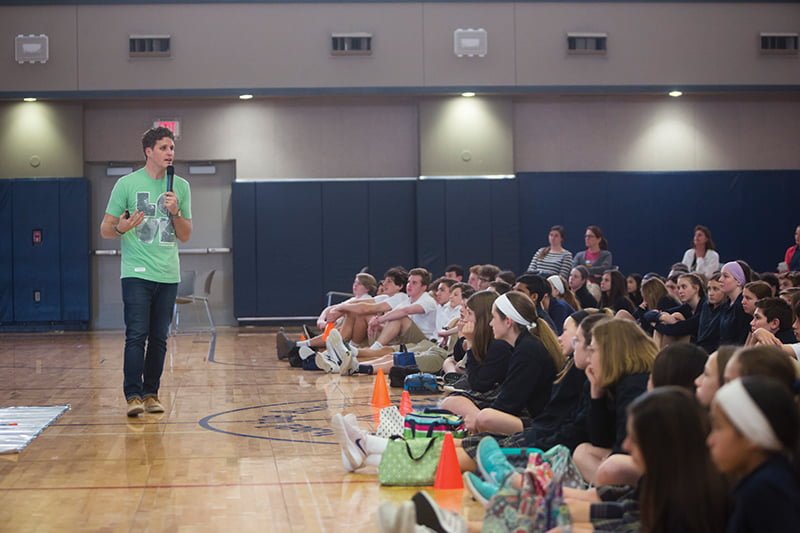
Clay Olsen, a co-founder of Fight the New Drug, delivers a presentation to seventh- and eighth-graders at St. Michael the Archangel School in Leawood on April 12. LEAVEN PHOTO BY DOUG HESSE
by Olivia Martin
olivia.martin@theleaven.org
LEAWOOD — Remember the good ol’ days when children were prescribed cocaine pills for toothaches?
Or nursing mothers were prescribed alcohol for the health benefits it would pass on to their babies?
Both have been true in recent history, explained Clay Olsen in a presentation to seventh- and eighth-graders at St. Michael the Archangel School in Leawood on April 12.
And each has been proven extremely harmful by modern science.
“Science had to catch up with truth,” said Olsen. “Once science figures it out, then society catches up.”
Olsen’s reason for sharing these examples was both serious and sobering.
“We are in a similar learning experience today in our history regarding the topic of pornography,” said Olsen. “Today, thanks to research and studies, we’ve now discovered that pornography is harming us . . . and is impacting us neurologically [and] relationally. It’s impacting our society.”
Olsen is a co-founder of Fight the New Drug, a nonprofit organization committed to using nothing but facts from scientific study, research and personal accounts to educate and communicate the harmful effects of pornography. He travels the world addressing the harms of pornography.
Olsen began by explaining the science behind addiction.
“There is an actual science behind why addiction happens,” he said. “Inside of the brain you each have a reward pathway. Inside the reward pathway when you do something cool or fun that you like, pleasure chemicals like dopamine are released. Between those neuro connectors, it makes you want to repeat that behavior.”
Olsen explained that when drugs are introduced into the body, it forces the release of pleasure chemicals in the reward pathway to the point where the brain builds a dependency to that level of release.
“You end up choosing that addictive behavior over the things you once knew you liked to do just to feel normal,” said Olsen.
“Based on studies coming out of Yale, Cambridge and many other locations doing brain scans and studies on this subject,” he said, “we now know that when it comes to the brain, addiction is addiction.”
Regardless of the source.
And pornography consumption can create addiction, which is due to the neuroplasticity of the brain.
“That was a huge discovery to help us understand that not all addictions come from chemicals you put inside your body,” he said.
“[The brain] is constantly changing, adapting and rewiring according to what you do, think and consume on a regular basis — what you spend your time focusing on,” said Olsen.
That neuroplastic process, while it allows for adaptation and growth, can be a massive disadvantage if the brain is hijacked by frequent or even periodic pornography consumption, Olsen explained.
In addition to outlining how viewing pornography impacts the brain in the same way as a drug, he also discussed its impact on the heart and society, from what and how much people love to how they think about loved ones and how they express love.
Drawing on personal accounts from people like Terry Crews, an NFL player and actor, and Garrett Johnson, a man who ran 30 marathons in 30 days in handcuffs and rode his bike across America in chains to fight his pornography addiction and raise awareness, Olsen stressed that pornography is not a battle without victories.
“Relationships are powerful, and they are at the center of where we find a lot of happiness and joy in this life,” he said. “This topic is far more about fighting for real love and real connection.”
While challenging the middle schoolers to take courage and openly speak out about the counterfeit version of love and intimacy pornography sells, he warned:
“A lot of times people refer to themselves as a bad person for dealing with this. Rather than using that kind of framework to describe yourself or anybody else, we need to respond with love and support and encouragement. If we do that, we’re going to move forward in a healthier direction as a collective society.”
“Can you guys do that?” he asked. “Can you respond with love and support rather than shame and judgment?”
Students had a moment at the end of the presentation to sign the Fighter Pledge, promising to be fighters for real and authentic love, unintimidated by society’s lies or the destructive lies of the pornography industry.
“We can feel overwhelmed [at times],” said Father Brian Schieber in a closing prayer, “but together, when we’re supporting each other, [change] is possible.”
After the presentation, parents had an opportunity to participate in a Q&A session with Olsen.
From questions about how pornography has fueled the #MeToo movement to whether pornography has affected Europe differently than America, Olsen pointed out that because we all share the same brains, pornography is harming our societies in very similar ways regardless of culture.
But those questions were only the beginning.
“A lot of parents ask what the signs of [pornography consumption] are,” began Olsen, saying many times they’re the same as simply being a teenager.
“[And] it’s not a question of ‘if’ my kid has been exposed to it,” he added. “‘If’ is out the window — it is a question of ‘when’ and ‘to what degree.’
“It’s impacting across the board (culturally, economically and religiously). It’s impacting us all.”
Advocating for “one-time” talks about pornography and healthy relationships to be things of the past, Olsen pleaded with parents to start early — when children are 7 or 8 years old — and engage in ongoing conversations with them.
“When you open up this conversation . . . don’t say much,” said Olsen. “Ask questions and listen. Figure out where their understanding is, what knowledge they have, what misconceptions they have, and listen, let them open up without jumping down their throat.
“Second, research the facts. . . help them understand.
“Third, share your family values and belief system.
“Fourth, repeat.”
While the widespread and pernicious nature of pornography can be daunting, Olsen encouraged parents to take heart, breathe and focus on teaching something more important than the dangers of pornography: love.
“We want to teach them about the good and the beauty before we teach them about the counterfeits,” he said. “Porn kills love. . . . Over time, we’ve seen this movement (against pornography) expand into a movement for love. We are fighting for real connection, real intimacy and real love. It’s pretty inspiring.”
For research, sources, real personal accounts and more, visit the website.






